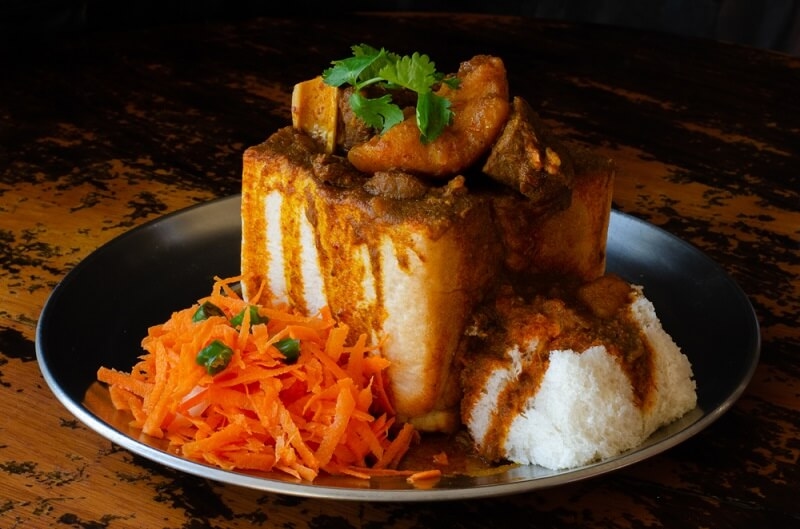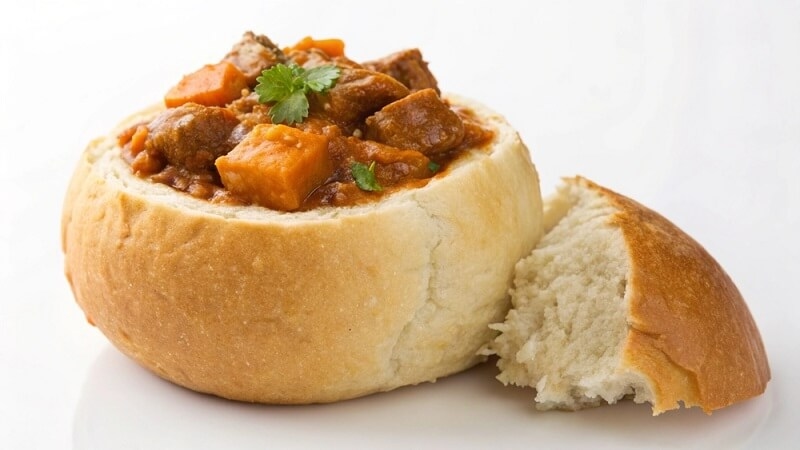
If you've ever wanted to experience the heart and soul of South Africa in one dish, the Bunny Chow Recipe is the dish for you. This iconic bread bowl filled with delicious curry is not just a meal, it's history, culture, and community served in edible format. While the dish itself originated in Durban, the recipe is now indicative of Durban style, a reflection of both cultures through rich history, with its union of Indian cuisine and African curry dishes. It's also now a popular recipe for street food in Durban around the world.
For the foodie who wants to try to put their spin on a new style of food at home, this article is a guide on how to make bunny chow at home.. By the end, you'll be able to prepare this spicy, filling, and comforting treat right in your kitchen.
The Bunny Chow Recipe is not your run-of-the-mill dish in the world of food. Consider taking a loaf of white bread and hollowing it out to fill with delicious curry. The bread becomes a sponge for the sauce, saturating itself to become a soft, savory sponge that you can enjoy with the filling.
Its uniqueness is not just the presentation but the tastes. A Bunny Chow typically uses lamb, chicken, or beans as the curry base and is freely sprinkled with chili, cumin, turmeric, and coriander. This puts it at the top of traditional spicy African comfort foods, if you enjoy hot spicy dishes.
Before jumping into how to prepare bunny chow at home, it's interesting to know where it came from. Bunny Chow originated in the 1940s in Durban, South Africa, when Indian immigrants devised this dish as a convenient means of transporting curry to work without using utensils. Bread, which was hollowed out, cost less than containers and served as both a container and food.
It fast became a staple dish of Durban street food recipes and swept across South Africa, and was accepted all over the world. Even today, Bunny Chow is served in numerous restaurants in London, New York, and, not to mention, other major cities, yet it still has ties back to Durban's streets.
When learning how to prepare bunny chow at home, the initial step is acquiring genuine ingredients. You don't have to fly to South Africa—most of these can be found in shops everywhere.
Key Ingredients:
Now, let's dive into the center of the Bunny Chow Recipe. Preparing it might seem daunting, but if you break it down, it's doable and extremely gratifying.
Slice the loaf of bread, cutting off one end and separating it into halves or quarters, depending on how big you want your serving size to be. Get rid of the inside of the bread, leaving the outer crust intact so it resembles a bowl.
Keep the bread pieces you took out for later use for dipping!
Incorporate the potatoes and the broth. Let it simmer until the curry thickens and the potatoes become tender.
There's something intensely gratifying about this meal that makes it more than a meal. The hot curry combined with soft bread makes Bunny Chow a textbook definition of spicy African comfort food.
It's sociable, fun to eat, and has a flavour punch that could tell the story of South Africa's multiculturalism. Each mouthful is spicy, rich, and the sheer thrill of eating with your hands which is so comforting and primal.

Because Bunny Chow is part of the realm of Durban street food recipes, it has experienced endless variations.
All these variations capture the essence of Durban but with something different for each taste bud.
While Bunny Chow is filling enough to eat on its own, it was served with sides to enhance the experience.
So, your instance of Bunny Chow Recipe has become a new experience altogether, while respecting its history as street food, and bringing it up to restaurant quality.
Learning any African curry recipes, including Bunny Chow, is a combination of spice and skill.
With these tips, your Bunny Chow will taste authentic no matter where you learn to cook it.
Preparing a Bunny Chow Recipe in contemporary kitchens isn't about sacrificing authenticity. With the world's access to spices and types of bread today, it's possible for anyone to make this original dish. Even whole-wheat or gluten-free bread can be used to prepare a healthier version.
What is great about mastering how to prepare bunny chow at home is that you can personalize it to suit your lifestyle without sacrificing its cultural appeal.
At its essence, the Bunny Chow Recipe is a dish that has a story to tell. Its origins were in Durban CBD, before Bunny Chow became an international food trend on its own. It is the food equivalent of Culture proudly showcased on a plate. Whether you’re making it as a fun weekend project or serving it at a dinner party, Bunny Chow will leave your guests talking about more than just food—it sparks conversations about history, culture, and comfort.
So, take a loaf of bread, prepare a dense curry, and relish the enchantment of South Africa's most popular bread bowl.
Q1: Can Bunny Chow be vegetarian?
Yes! A lentil or bean curry goes great in the bread bowl, giving it a delicious vegetarian option.
Q2: What bread is ideal for Bunny Chow?
A thick, white, soft loaf is traditional. It should be unsliced so that you can hollow it out correctly.
Q3: Is Bunny Chow always hot?
Yes, traditionally. However, you can adjust the levels of chili and curry powder to suit your taste.
Q4: How did Bunny Chow originate?
It's supposed to be derived from the term "bania," which was used to describe Indian merchants who made the dish popular in Durban.
This content was created by AI